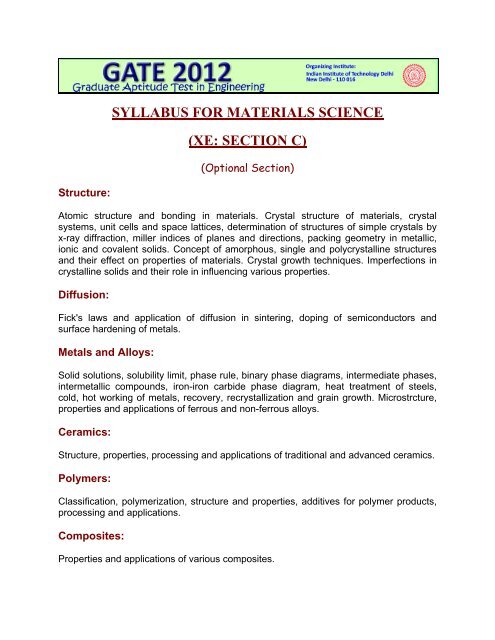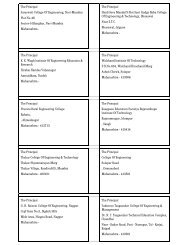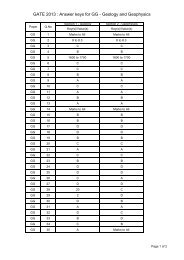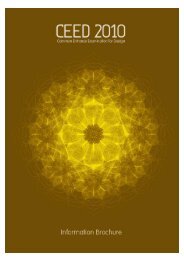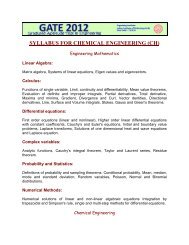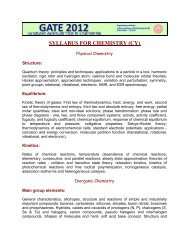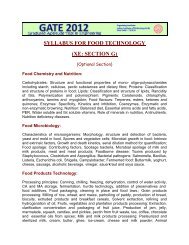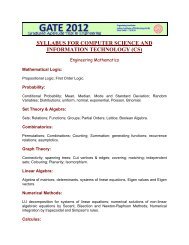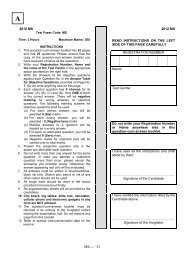SYLLABUS FOR MATERIALS SCIENCE (XE: SECTION C)
SYLLABUS FOR MATERIALS SCIENCE (XE: SECTION C)
SYLLABUS FOR MATERIALS SCIENCE (XE: SECTION C)
You also want an ePaper? Increase the reach of your titles
YUMPU automatically turns print PDFs into web optimized ePapers that Google loves.
Structure:<br />
<strong>SYLLABUS</strong> <strong>FOR</strong> <strong>MATERIALS</strong> <strong>SCIENCE</strong><br />
(<strong>XE</strong>: <strong>SECTION</strong> C)<br />
(Optional Section)<br />
Atomic structure and bonding in materials. Crystal structure of materials, crystal<br />
systems, unit cells and space lattices, determination of structures of simple crystals by<br />
x-ray diffraction, miller indices of planes and directions, packing geometry in metallic,<br />
ionic and covalent solids. Concept of amorphous, single and polycrystalline structures<br />
and their effect on properties of materials. Crystal growth techniques. Imperfections in<br />
crystalline solids and their role in influencing various properties.<br />
Diffusion:<br />
Fick's laws and application of diffusion in sintering, doping of semiconductors and<br />
surface hardening of metals.<br />
Metals and Alloys:<br />
Solid solutions, solubility limit, phase rule, binary phase diagrams, intermediate phases,<br />
intermetallic compounds, iron-iron carbide phase diagram, heat treatment of steels,<br />
cold, hot working of metals, recovery, recrystallization and grain growth. Microstrcture,<br />
properties and applications of ferrous and non-ferrous alloys.<br />
Ceramics:<br />
Structure, properties, processing and applications of traditional and advanced ceramics.<br />
Polymers:<br />
Classification, polymerization, structure and properties, additives for polymer products,<br />
processing and applications.<br />
Composites:<br />
Properties and applications of various composites.
Advanced Materials and Tools:<br />
Smart materials, exhibiting ferroelectric, piezoelectric, optoelectric, semiconducting<br />
behavior, lasers and optical fibers, photoconductivity and superconductivity,<br />
nanomaterials , synthesis, properties and applications, biomaterials, superalloys, shape<br />
memory alloys. Materials characterization techniques such as, scanning electron<br />
microscopy, transmission electron microscopy, atomic force microscopy, scanning<br />
tunneling microscopy, atomic absorption spectroscopy, differential scanning calorimetry.<br />
Mechanical Properties:<br />
Stress-strain diagrams of metallic, ceramic and polymeric materials, modulus of<br />
elasticity, yield strength, tensile strength, toughness, elongation, plastic deformation,<br />
viscoelasticity, hardness, impact strength, creep, fatigue, ductile and brittle fracture.<br />
Thermal Properties:<br />
Heat capacity, thermal conductivity, thermal expansion of materials.<br />
Electronic Properties:<br />
Concept of energy band diagram for materials - conductors, semiconductors and<br />
insulators, electrical conductivity effect of temperature on conductility, intrinsic and<br />
extrinsic semiconductors, dielectric properties.<br />
Optical Properties:<br />
Reflection, refraction, absorption and transmission of electromagnetic radiation in solids.<br />
Magnetic Properties:<br />
Origin of magnetism in metallic and ceramic materials, paramagnetism, diamagnetism,<br />
antiferro magnetism, ferromagnetism, ferrimagnetism, magnetic hysterisis.<br />
Environmental Degradation:<br />
Corrosion and oxidation of materials, prevention.


